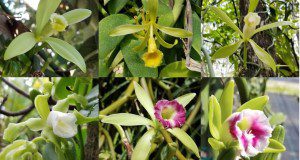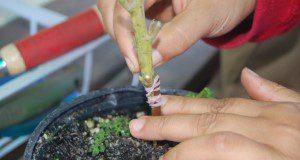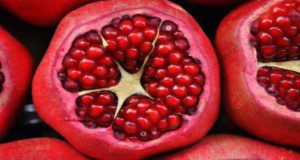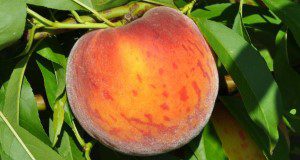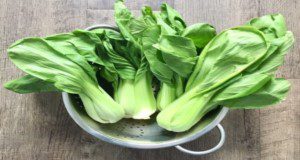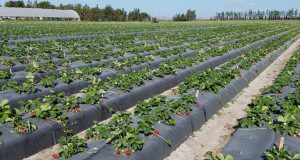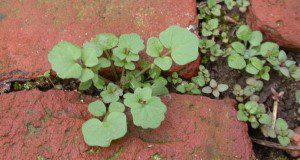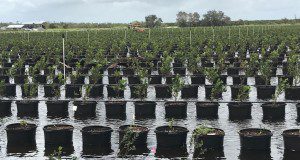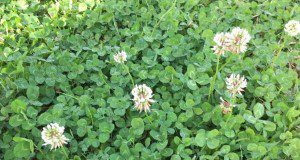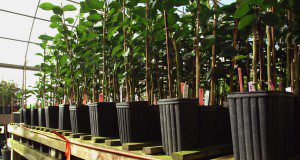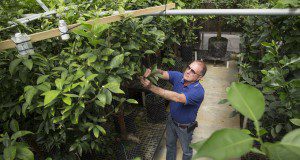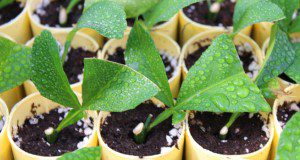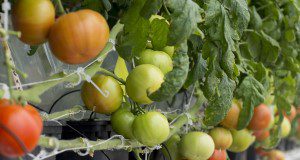Quantification of plant phenotypic traits, such as height, width, stem diameter, and leaf area, is often performed manually in the field; however, these measurements can be performed more quickly and precisely through simple imaging techniques using an image processing program. This new 5-page publication of the UF/IFAS Horticultural Sciences Department, written by Shinsuke Agehara, describes simple imaging techniques for plant growth assessment using the public domain program ImageJ.
https://edis.ifas.ufl.edu/hs1353
Tag: Horticultural Sciences Department
Choosing the Right Blackberry Cultivar in Subtropical Florida
Blackberry (Rubus spp.) is a deciduous berry crop and the fourth most economically important berry crop in the United States. Driven by the growing demand for blackberries, production recently expanded to the southeastern United States. In Florida, however, commercial blackberry production is limited primarily to small commercial U-pick operations. The main challenges include insufficient chill hours and poor fruit quality associated with the subtropical climate. This new 6-page article, a publication of the UF/IFAS Horticultural Sciences Department, will discuss important cultivar selection criteria and recommended blackberry cultivars in subtropical Florida. Written by Shinsuke Agehara, Syuan-You Lin, and Zhanao Deng.
https://edis.ifas.ufl.edu/hs1352
Florida Citrus Rootstock Selection Guide, 4th Edition
This updated 4th edition of the Florida Citrus Rootstock Selection Guide (FLCRSG) is a revision of the 2016 publication. The guide is a convenient, easy-to-use reference to 21 characteristics of 49 rootstocks. Of those, 12 are time-honored commercial rootstocks (highlighted in blue), which are the most reliably characterized. The next 13 rootstocks are minor commercial ones (highlighted in green) that are less frequently used today in Florida but may have been prominent at one time. The third group consists of the most recently released 24 rootstocks (highlighted in yellow) for which there is limited commercial experience. The new addition includes three new USDA rootstocks and updates information on a few traits. Written by William S. Castle, Kim D. Bowman, Jude W. Grosser, Rhuanito Soranz Ferrarezi, Stephen H. Futch, and Steve Rogers, and published by the UF/IFAS Horticultural Sciences Department.
https://edis.ifas.ufl.edu/hs1260
Culture de la vanille dans le sud de la Floride
L’extrait de vanille est populaire dans le monde entier comme ingrédient dans la crème glacée et divers autres desserts. La source botanique de l’extrait de vanille provient principalement des gousses durcies (préparées) de l’espèce Vanilla planifolia. Les États-Unis sont les plus grands importateurs mondiaux de gousses de vanille, mais la production nationale est très faible. Toutefois, le sud de la Floride a un potentiel de production favorable á la culture de la vanille. Ce document contient des informations utiles aux producteurs intéressés par l’établissement d’une vanillerie.
This is the French version of HS1348, Vanilla Cultivation in Southern Florida. This new 9-page publication was written by Alan Chambers, Pamela Moon, Vovener de Verlands Edmond, and Elias Bassil, translated by Francesca Carla Erié, and published by the UF/IFAS Horticultural Sciences Department.
https://edis.ifas.ufl.edu/hs1351
Cultivo de vainilla en el sur de Florida
El extracto de vainilla es popular en el mundo entero como un ingrediente usado en helados y otros postres. La fuente botánica del extracto de vainilla es principalmente los frijoles curados de Vanilla planifolia. El Estados Unidos es el mayor importador mundial de vainilla judías, pero la producción nacional es mínima. El sur de la Florida tiene un clima de crecimiento favorable para el cultivo de vainilla. Este documento incluye información relevante para los productores interesados en establecer un cultivo de vainilla.
This is the Spanish version of HS1348, Vanilla Cultivation in Southern Florida. This new 8-page publication was written by Alan Chambers, Pamela Moon, Vovener de Verlands Edmond, and Elias Bassil, translated by Dayana Valdes, and published by the UF/IFAS Horticultural Sciences Department.
https://edis.ifas.ufl.edu/hs1350
Vanilla Cultivation in Southern Florida
Vanilla extract is popular around the world as an ingredient in ice cream and various other desserts. The botanical source of vanilla extract is primarily the cured beans of Vanilla planifolia. The United States is the world’s largest importer of vanilla beans, but domestic production is minimal. However, southern Florida has a favorable growing environment for vanilla cultivation. This new 7-page publication of the UF/IFAS Horticultural Sciences Department includes information relevant to growers interested in establishing a vanillery. Written by Alan H. Chambers, Pamela Moon, Vovener de Verlands Edmond, and Elias Bassil.
https://edis.ifas.ufl.edu/hs1348
Tropical and Subtropical Fruit Propagation
Propagation is an important technique used by tropical and subtropical fruit growers worldwide, allowing plants to be grown cheaply and efficiently. While sexual propagation (by seed) results in plants that are not genetically the same as the mother plant, asexual propagation (cuttings, division, air-layers, and grafting) creates offspring that are clones of the mother plant. Cloning fruit trees is important because it allows different cultivars to be preserved over time. This new 7-page publication of the UF/IFAS Horticultural Sciences Department explains both sexual and asexual propagation techniques, why they are used, and what type of propagation is best for which species of tropical fruit. Written by Jeff Wasielewski and Carlos Balerdi.
https://edis.ifas.ufl.edu/hs1349
Implementation of Anaerobic Soil Disinfestation in Florida Tomato Production
Anaerobic soil disinfestation (ASD) is a relatively new technique that appears to be a promising tool for soilborne pest management and crop production improvement. This new 5-page publication of the UF/IFAS Horticultural Sciences Department is intended to introduce ASD for Florida vegetable growers. Written by Bodh R. Paudel, Francesco Di Gioia, Qiang Zhu, Xin Zhao, Monica Ozores-Hampton, Marilyn E. Swisher, Kaylene Sattanno, Jason C. Hong, and Erin N. Rosskopf.
http://edis.ifas.ufl.edu/hs1345
Guidelines for Pomegranate Nutrient Management in Florida
Many Florida growers are interested in the potential of pomegranate as an alternative fruit crop. The first flush of flowers produces the best quality fruit, and climatic conditions have a great impact on the timing of flowering. Proper fertilization is critical to promote healthy canopy development, minimize nutrient disorders, and maximize fruit yield and quality. This new 5-page article, written by Shinsuke Agehara, Weining Wang, and Ali Sarkhosh and published by the UF/IFAS Horticultural Sciences Department, provides guidelines for pomegranate nutrient management in Florida.
https://edis.ifas.ufl.edu/hs1347
Variedades de Durazno y Nectarina en la Florida
La Universidad de la Florida ha desarrollado cultivares de nectarina y durazno de alta calidad, bajo requerimiento de horas frio, y de maduracion temprana que pueden cultivarse desde el Panhandle de la Florida (noroeste del estado) tan al sur como Immokalee. Cultivares de bajas horas frio pueden crecer y producir fruta bajo las condiciones de la Florida que son mucho mas calidas en el invierno que en estados mas al norte. This 18-page fact sheet, translated by Tatiana Sanchez and published by the UF/IFAS Horticultural Sciences Department, is the Spanish-language version of CIR1159, Florida Peach and Nectarine Varieties, written by Ali Sarkhosh, Mercy Olmstead, Jose Chaparro, Pete Andersen, and Jeff Williamson.
https://edis.ifas.ufl.edu/hs1346
Bok Choy, an Asian Leafy Green Vegetable Emerging in Florida
Asian vegetable crops are rapidly expanding in Florida in the last decade due to their health benefits combined with their high profitability. These crops can help increase vegetable growers’ income and diversify Florida’s crop production, and they are new to most Floridians. This new 5-page article provides a general overview of bok choy for vegetable growers, crop consultants, certified crop advisors, Extension agents, and graduate students. Written by Hai Liu and Guodong Liu and published by the UF/IFAS Horticultural Sciences Department.
https://edis.ifas.ufl.edu/hs1337
The UF/IFAS Strawberry Clean Plant Program
Florida strawberry growers primarily utilize cultivars developed by the UF/IFAS Strawberry Breeding Program. These cultivars are bred to provide the yield and quality traits needed by the Florida industry. Yet if a new cultivar has the traits that Florida growers need but pathogen-tested planting stock is not available to growers, the cultivar’s impact will be limited. The Clean Plant Program generates the pathogen-tested planting stock that nurseries and growers require. This new 5-page publication of the UF/IFAS Horticultural Sciences Department, written by Catalina Moyer, Natalia A. Peres, and Vance M. Whitaker, is intended to educate both the industry and the public on the importance of the Clean Plant Program and the methods used to produce planting stock of new cultivars.
https://edis.ifas.ufl.edu/hs1343
Stock Plant and Tree Production: Weed Management in Citrus Nurseries
All citrus nursery stock in Florida is raised in enclosed greenhouses. It is not uncommon for weeds to grow in containers, where they compete with citrus seedlings, and on greenhouse floors, where they can harbor pests and diseases. This new 7-page publication of the UF/IFAS Horticultural Sciences Department provides descriptions of a few commonly found weeds in citrus nurseries and good weed management practices. Written by Biwek Gairhe, Ramdas Kanissery, and Brent Sellers, this article is chapter 8c of the forthcoming Citrus Nursery Production Guide.
https://edis.ifas.ufl.edu/hs1344
Impacts of Hurricane Damage on Southern Highbush Blueberries
Florida has been affected by eight hurricanes since 2000. This new 3-page publication discusses the types of hurricane damage that occur in blueberry production operations, the impacts of these damages, and some recommendations on best management practices in the aftermath of a storm. Written by Douglas A. Phillips, Jeffrey G. Williamson, and Philip F. Harmon and published by the UF/IFAS Horticultural Sciences Department.
https://edis.ifas.ufl.edu/hs1342
Weeds as Reservoirs of Plant Pathogens Affecting Economically Important Crops
Weeds are a major contributor to yield loss and reduction in yield quality in an agricultural setting, competing with the crop for resources like light, water, and nutrients. This competition, along with the cost of weed management strategies like tillage and herbicides, is responsible for the economic impact of weeds, which can reach into the billions. Weeds can also harm crop plants by acting as reservoirs for destructive plant pathogens, the insect vectors that move these pathogens from plant to plant, or both. This new 7-page publication of the UF/IFAS Horticultural Sciences Department, written by Morgan Byron, Danielle Treadwell, and Peter Dittmar, summarizes previously published weed-pathogen associations to help growers scout and monitor pathogens in weeds near production areas.
https://edis.ifas.ufl.edu/hs1335
Identification and Management of Clustered Pellitory (Parietaria praetermissa) in Citrus Groves
In Florida, clustered pellitory is becoming a troublesome weed for citrus, especially from the winter through early summer. Inadequate management of this weed can result in its heavy infestation in tree rows and can interrupt the spray pattern of low-volume drip irrigation systems. This new 3-page publication of the UF/IFAS Horticultural Sciences Department will assist Florida citrus growers with proper identification of clustered pellitory and with adoption of adequate and timely strategies to manage this weed in their groves. Written by Ramdas Kanissery, Biwek Gairhe, Brent Sellers, and Steve Futch.
https://edis.ifas.ufl.edu/hs1341
Rootstock Selection
The large number of different rootstock varieties currently available for citrus production in Florida is unprecedented. This new 4-page article, chapter 4 of the forthcoming UF/IFAS Citrus Nursery Production Guide, provides information on rootstock uses in Florida, rootstock propagation, and the impact of tissue culture, as well as factors to consider when deciding which rootstock to plant. Written by Ute Albrecht, Manjul Dutt, and Jude Grosser and published by the UF/IFAS Horticultural Sciences Department.
https://edis.ifas.ufl.edu/hs1340
Seed and Budwood Production, Transport, and Conservation
The Florida citrus industry maintains a high demand for trees for replanting and resetting, as well as an interest in new releases of rootstocks and scions with improved disease and abiotic stress tolerances. One of the main constraints for liner production in great numbers is time. The consensus among citrus nurseries is that it takes two years to produce enough quantities of budwood to establish seed block trees when a new interesting rootstock is produced. This new 3-page article addresses the practices and challenges of producing seeds and budwood in Florida. This article, chapter 7 of the forthcoming Citrus Nursery Production Guide, was written by Fernando Alferez and Mireia Bordas and is a publication of the UF/IFAS Horticultural Sciences Department.
https://edis.ifas.ufl.edu/hs1336
Citrus Rootstock Propagation: Traditional Techniques and Recent Advances
Commercially grown citrus trees are usually composed of two parts: 1) the scion, which is the aboveground portion of the tree that produces the fruit, and 2) the rootstock, which comprises the root system and the lower portion of the trunk. This new 4-page publication, chapter 6 of the forthcoming Citrus Nursery Production Guide, discusses three kinds of rootstock propagation: seed, cuttings, and tissue culture. Written by Ute Albrecht, Lorenzo Rossi, and Mongi Zekri and published by the UF/IFAS Horticultural Sciences Department.
https://edis.ifas.ufl.edu/hs1329
Current Status of Research, Regulations, and Future Challenges for CRISPR Gene Editing in Crop Improvement
Recently, new plant-breeding technology such as CRISPR gene editing has provided the potential to substantially improve crop breeding in agriculture. Considerable efforts have been devoted to apply this gene-editing technology in modern agriculture to increase crop yields and improve the quality of food ingredients, especially by many of the major agronomic seed-producing companies. In this new 4-page article, we outline the recent research updates and regulations on gene editing in crop improvement. Written by Sadikshya Sharma, Heqiang Huo, and Seonghee Lee and published by the UF/IFAS Horticultural Sciences Department.
https://edis.ifas.ufl.edu/hs1334



